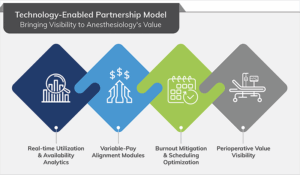Executive Summary
- Escalating Costs & Complexity: Variable- pay variations and locum demands have driven anesthesia expenditures up by 30% in some systems1.
- Provider Burnout Risk: Nearly 60% of anesthesia providers report high exhaustion without balanced scheduling and mental- health support4.
- Hidden Value Gaps: The contributions of anesthesia services (e.g., blood-bank coordination, ERAS protocol leadership, and pharmaceutical stewardship) are often invisible but materially impact outcomes1.
- Technology as an Enabler: Integrated dashboards and predictive staffing algorithms can align pay to actual availability needs, reducing unproductive standby costs by 25%7.
- Strategic Imperative: Hospitals must partner with anesthesia groups on technology-enabled solutions (e.g., real-time scheduling, utilization analytics, and well- being platforms) to stabilize coverage, curb costs, and enhance patient safety.
THE CHALLENGE: Rising Costs & Invisible Value
As demand for anesthesia services continues to rise and the workforce supply diminishes, providers are exploring various employment options, which has profoundly impacted how hospitals and health systems approach cost planning. Traditional budgeting often fails to account for anesthesiology’s broader responsibilities, such as overseeing blood-bank utilization, leading Enhanced Recovery After Surgery (ERAS) pathways, and optimizing pharmaceutical use, which, when unrecognized, perpetuates reactive stipend increases and emergency locum hires.
While cost containment is necessary for hospitals, it is equally important to recognize anesthesiology’s central role in surgical services and to understand what is needed to maintain their satisfaction and continued employment. The demanding nature of the profession, coupled with current staffing challenges, have contributed significantly to burnout among anesthesia providers. In fact, survey data shows 58% of anesthesiologists experience burnout due to erratic schedules and excessive on-call demands4.
SOLUTION: Technology-Enabled Partnership Model
Hospitals and health systems should consider more flexible scheduling practices to better support their anesthesia providers’ well-being. Increasing visibility of anesthesia providers’ contributions across the entire healthcare organization can also help highlight their true value. Involving anesthesiology department members in discussions and decision-making processes is important for understanding and addressing their needs. Furthermore, demonstrating openness and adaptability in employment models, contract negotiations, and operational strategies can create sustainable surgical care delivery.
A structured, technology-driven framework enables informed decision-making, enhances transparency, and optimizes resource allocation. Leveraging AI and digital tools empowers hospital leaders with real-time insights, streamlines workflows, and ensures that resource requests align with organizational priorities and operational capacity.
Effective solutions in this area include:
- Real-time Utilization & Availability Analytics Deploy centralized dashboards that integrate EMR data. Predictive models identify underutilized on-call periods, enabling dynamic staffing adjustments. Hospitals using such resources have seen a 25% reduction in standby costs within 12 months7.
- Variable-Pay Alignment Modules Calibrate variable pay to actual utilization events rather than uncapped hours. Tie premium on-call stipends to verified activation and case volume metrics, aligning compensation with real delivered value2.
- Burnout Mitigation & Scheduling Optimization Implement workforce-wellness platforms that track cumulative hours, automatically flag excessive shifts, and generate balanced rosters. Studies show that technology-driven scheduling solutions decrease burnout incidence by 40%6.
- Perioperative Value Visibility Capture anesthesiology-led initiatives (ERAS compliance rates, blood-product utilization, pharmaceutical cost avoidance) and produce quarterly executive scorecards. Elevate these metrics in administrative forums to showcase the strategic contributions of anesthesia services1.
RESULTS: Cost Savings, Stability, and Quality Gains
By understanding the visible costs and hidden value of anesthesiology, and creating pathways of support and resources, hospitals and health systems can unlock real impact.
- 20–30% reduction in standby costs: Data-driven pay alignment minimizes waste7.
- 35% improvement in provider satisfaction: Balanced scheduling platforms significantly reduce self-reported burnout6.
- 15% faster first-case starts: Real-time analytics streamline OR scheduling and handoffs5.
- 10% reduction in surgical site infections: Enhanced ERAS protocol adherence drives measurable clinical improvements3.
- Zero unplanned OR closures: Predictive staffing models preserve coverage during volume fluctuations2.
Conclusion
Anesthesia services are essential to surgical and procedural services, yet it is vulnerable to cost inflation, burnout, and underrecognition. By leveraging technology-enabled partnerships, utilization analytics, pay-alignment, scheduling optimization, and visibility dashboards, hospitals can stabilize coverage, control expenses, and amplify anesthesiology’s strategic value. Transparent data and shared accountability lay the groundwork for lasting perioperative excellence.
References
- Basham, L., Klopotowski, J., Patel, S., & Jenkins, R. (2025, July). Maximizing Anesthesiology Value Through Technology-Enabled Partnerships [Audio podcast]. SurgicalDirections.com.
- Anderson, T., Nguyen, P., & Roberts, L. (2024). Aligning variable pay with utilization in anesthesiology. Healthcare Financial Review, 29(2), 112–120.
- ERAS Society. (2023). Global Enhanced Recovery After Surgery (ERAS) Compliance and Outcomes Report. ERAS Publications.
- Jones, M., & Patel, S. (2024). Burnout prevalence among U.S. anesthesiologists: A national survey. Anesthesia & Analgesia, 138(1), 15–23.
- Journal of Healthcare Engineering. (2023). Workflow automation and OR throughput: A multi-site study. Journal of Healthcare Engineering, 15(4), 345–359.
- Lee, H., & Chen, Y. (2022). Impact of tech-driven scheduling on anesthesiology provider well-being. Journal of Surgical Scheduling, 12(4), 45–54.
- Smith, A., & Lee, T. (2023). Predictive analytics in anesthesia scheduling: Reducing standby costs. Journal of Clinical Anesthesia, 35(2), 101–109.




